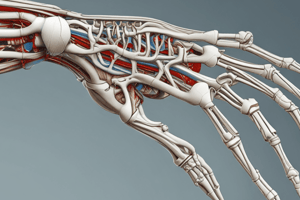Podcast
Questions and Answers
What type of joint is characterized by the absence of movement due to the strong fibrous tissue connection?
What type of joint is characterized by the absence of movement due to the strong fibrous tissue connection?
- Synovial joint
- Synchondrosis
- Cartilaginous joint
- Fibrous joint (correct)
Which of the following examples represents a permanent cartilaginous joint?
Which of the following examples represents a permanent cartilaginous joint?
- Intervertebral discs (correct)
- Joints between occipital and sphenoid bones of the skull
- Epiphyseal plates of long bones
- Between the 1st rib and manubrium
What distinguishes primary cartilaginous joints from secondary cartilaginous joints?
What distinguishes primary cartilaginous joints from secondary cartilaginous joints?
- Primary joints ossify earlier than secondary joints.
- Primary joints are temporary, secondary are permanent. (correct)
- Primary joints have a fibrocartilaginous disc, secondary do not.
- Primary joints allow movement, secondary do not.
Which of the following is NOT a feature of synovial joints?
Which of the following is NOT a feature of synovial joints?
In which joint type are the bones connected by a disc of fibrocartilage?
In which joint type are the bones connected by a disc of fibrocartilage?
Which of the following statements about sutures of the skull is accurate?
Which of the following statements about sutures of the skull is accurate?
What type of connective tissue primarily connects bones in primary cartilaginous joints?
What type of connective tissue primarily connects bones in primary cartilaginous joints?
Which type of joint is characterized by the presence of articular capsules and synovial fluid?
Which type of joint is characterized by the presence of articular capsules and synovial fluid?
Which type of fibrous joint is between the teeth and the jaws?
Which type of fibrous joint is between the teeth and the jaws?
Flashcards are hidden until you start studying
Study Notes
Definition of Joints
- A joint is the site where 2 or more bones meet.
Classification of Joints
- Joints are classified into 3 types based on the tissues between the bones: fibrous, cartilaginous, and synovial.
Fibrous Joints
- Characterized by strong fibrous tissue connecting articular surfaces with no movement permitted.
- Types of fibrous joints:
- Sutures of the skull: Thin fibrous tissue that frequently ossifies with age.
- Syndesmosis: Inferior tibio-fibular joint with a strong interosseous ligament that does not ossify.
- Gomphosis: Fibrous joints between teeth and jaws that do not ossify.
Cartilaginous Joints
- Classified into primary and secondary.
- Primary Cartilaginous Joints:
- Bones connected by hyaline cartilage.
- No movements permitted.
- Temporary (ossifies later).
- Examples: Epiphyseal plates of long bones, between occipital and sphenoid bones of skull, and between 1st rib and manubrium.
- Secondary Cartilaginous Joints:
- Bones connected by a disc of fibrocartilage.
- Little movement permitted.
- Permanent (does not ossify).
- Examples: Intervertebral discs, symphysis pubis, and joints between the pieces of the sternum.
Synovial Joints
- Freely movable joints.
- Structure of a Synovial Joint:
- Articular surfaces covered by a thin plate of hyaline cartilage (articular cartilage).
- Joint cavity separates articular surfaces.
- Fibrous capsule surrounds the joint cavity.
- Capsule pierced by articular vessels and sometimes by bursae or tendons.
- Capsule occasionally thickened to form capsular ligaments.
Studying That Suits You
Use AI to generate personalized quizzes and flashcards to suit your learning preferences.




